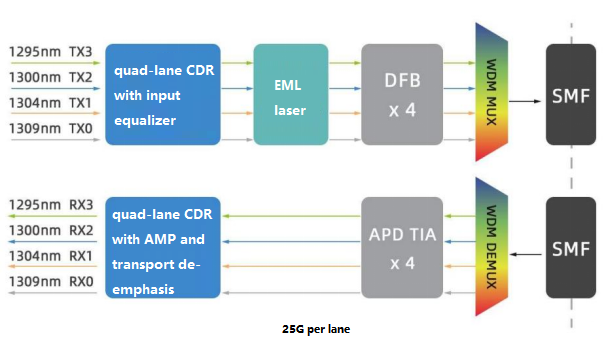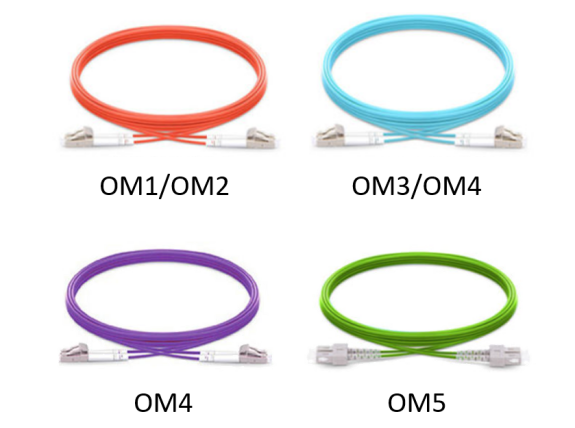According to the optical signal transmission mode in the fiber, optical fibers can be divided into single-mode fiber and multi-mode fiber.
In the transmission network and wired access network, the main types of fiber are G.652, G.654, and G.657, which are single-mode fibers. Multi-mode optical fibers are mainly used for short-distance communication, such as interconnection between devices in a data center.
According to the material, multi-mode fiber is divided into glass fiber and plastic fiber. Plastic fiber is mainly used in industrial control and automotive entertainment systems, the overall proportion is relatively low. The commonly used multi-mode fiber in communication is made of glass, and the common types include: OM1, OM2, OM3, OM4, and OM5; The main differences between these fibers are mode bandwidth and SWDM support.
Modal Bandwidth
Modal bandwidth is an important index reflecting the bandwidth capacity of multi-mode fiber, which can be simply understood as: the product of the maximum frequency of the signal transmitted in the fiber and its transmission length.
For example, at 850nm wavelength, if the minimum mode bandwidth of the fiber is 200MHz·km, it means that when the fiber is 1km long, it can transmit signals with a maximum frequency of 200MHz. When the length is 500m, the maximum signal transmission can be 400MHz(200MHz x 1km/0.5km = 400MHz).
The modal bandwidths of multi-mode fibers are related to the wavelength of the channel. The minimum mode bandwidths of OM1, OM2, OM3, OM4, and OM5 fibers at 850nm and 953nm are shown in the table below.

There is generally no difference between OM4 and OM5 in the minimum modal bandwidth of 850nm. The difference lies in the support for SWDM.
Support for SWDM
In the single-mode transmission system, the optical modules with the rate of 100G and above all adopt WDM technology. For example, 100G ER4(40km) optical modules generally adopt LWDM.

To improve the transmission rate of a single fiber, multi-mode fiber also proposed a WDM solution, called SWDM. SWDM is short-wave wavelength division multiplexing, using the operating wavelengths from 850 nm, increasing every 30 nm, which is 880 nm, 910 nm, and 940 nm. Multi-mode fiber to support SDWM for OM5, OM5 is also known as broadband multimode fiber. This is not the same as saying that OM1 to OM4 fibers do not support SWDM, but the corresponding wavelengths in the SWDM did not have the requirements of the fiber indicators.

Maximum transmission distance
The maximum transmission distance of multi-mode fibers is mainly related to the mode bandwidth of the fiber and the type of optical module. The maximum transmission distance of optical modules with different rates is shown in the following table.

Core diameter and light source
OM1, OM2, OM3, OM4, and OM5 also differ in core diameter, type of light source used, and color of jumper jacket.
In general, the larger the core diameter of the fiber, the easier the coupling, but the smaller the mode bandwidth. The core diameters of OM1 and OM2 are 50um and 62.5um. The core diameters of OM3, OM4, and OM5 are all 50um.
The light source of OM1 and OM2 mainly uses LED, while the light source of OM3, OM4, and OM5 mainly use VCSEL (vertical cavity surface emitting laser).
To differentiate fiber types, the color of jumper jackets for OM1, OM2, OM3, OM4, and OM5 is also different: orange for OM1/OM2, aqua blue for OM3/OM4 (violet for some manufacturers), and light green for OM5.

Summary
OM1 and OM2 fibers have been gradually withdrawn from the market because they cannot support high-speed communication. OM5 fibers can better support SWDM, but high-speed optical modules using MPO/MTP solution (MPO/MTP is a multi-core connection interface) is more economical than SWDM solution, so the most current multi-mode fiber applications are still OM3 and OM4. It is recommended to use OM4 fiber, and if the investment is not sensitive, or the rate requirement of interconnection between devices is higher, OM5 fiber can also be used.
Currently, in addition to data centers, other telecommunications equipment interconnection fiber still uses single-mode fiber. Single-mode fiber is cheaper than multi-mode fiber. But at the same rate, the price of single-mode optical modules is much more expensive than multi-mode optical modules. If the interconnection of equipment in the core server room also uses multi-mode fiber, it may save a considerable investment.
